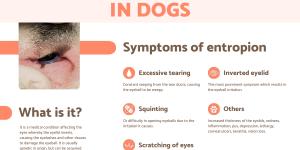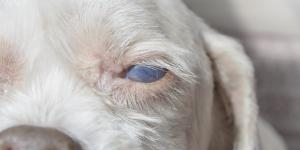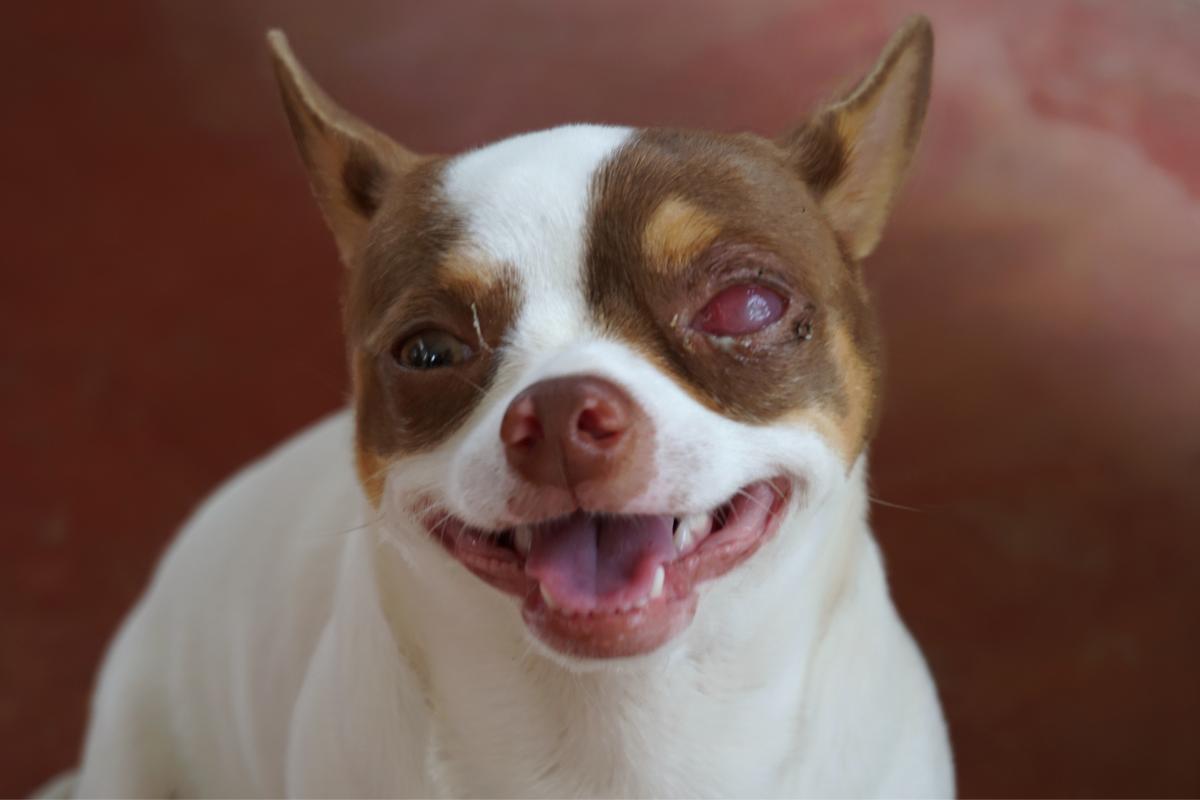Microphthalmia in Dogs - Signs and Treatment



See files for Dogs
Microphthalmia is an uncommon yet significant condition that affects the development of a dog's eyes. Characterized by abnormally small eyes, microphthalmia can range in severity and impact a dog's vision to varying degrees. While genetic factors often underlie this condition, other causes such as intrauterine infections, nutritional deficiencies, and trauma can also contribute to its development.
To better understand this condition and its implications for our dogs, in this article of AnimalWised we explore what microphthalmia in dogs is, its causes, symptoms, and treatment options.
What is microphthalmia in dogs?
Canine microphthalmia is a rare congenital eye condition in which the eyeball is abnormally small. Affected dogs may have a prominent third eyelid and sunken eyes (enophthalmos). Microphthalmia can be a mild or severe condition. In some cases, it may not cause any vision problems. However, in more severe cases, microphthalmia can lead to blindness.
It is important to distinguish microphthalmia from problems with the third eyelid or eye socket, as the primary issue lies within the eyeball itself.
Microphthalmia is more common in dogs with a Merle coat and white markings. In these cases, it is often associated with other eye defects and may also be associated with deafness. This is because the Merle gene, which is responsible for the Merle coat pattern, can also cause defects in the development of the eyes and ears.
Microphthalmia can also be inherited as an autosomal recessive trait in certain breeds, such as Doberman Pinschers and Miniature Schnauzers.
Autosomal recessive inheritance means that both parents must carry a copy of the defective gene in order for the offspring to be affected by the condition. In the case of microphthalmia, this means that both parents must carry a copy of the Merle gene.
Breeding practices that avoid selecting dogs with this abnormality can help to reduce the risk of microphthalmia in future generations. There is no cure for microphthalmia, but there are treatments that can help to manage the symptoms and improve the quality of life for affected dogs.
In addition to microphthalmia, there are various eye conditions that can impact dogs. In our other article on blood in a dog's eye, we explore another important eye health issue.
Source: University of California, Davis, Veterinary Ophthalmology Service Collection.

Symptoms of microphthalmia in dogs
Microphthalmia in dogs typically manifests as one or both eyes having a smaller diameter than normal. This condition can be accompanied by various issues such as corneal malformation, a smaller orbit, eyelid abnormalities, and, to a lesser extent, blindness.
The most concerning aspect of microphthalmia is the associated symptoms, which may include:
- Cataracts: clouding of the lens of the eye.
- Corneal opacity: clouding of the cornea, the clear front part of the eye.
- Persistent pupillary membrane: a thin piece of tissue that remains in front of the pupil after birth.
- Retinal dysplasia: abnormal development of the retina, the light-sensitive tissue at the back of the eye.
- Anterior segment dysgenesis: defects in the front part of the eye, including the cornea, iris, and lens.
- Collie eye anomaly: a group of eye defects that are common in Collie dogs.
Microphthalmia can occur in different degrees and may be linked to other ocular pathologies, major or minor.
Some estimates suggest that around 50% of puppies affected by microphthalmia are blind. Those with cataracts in conjunction with microphthalmia may experience varying degrees of visual impairment. The progression of this condition is unpredictable, as cataracts can either gradually reduce vision or be reabsorbed.
In dogs with the Merle gene expression, other complications can arise, including microcornea, heterochromatic irises, cataracts, staphyloma, retinal detachment, irregular pupils, white or blue irises, iris coloboma, angular dysgenesis, and blindness.
If you found the article on microphthalmia in dogs informative, you might also be interested in our article on another eye condition, why is my dog’s eye swollen?

Causes of microphthalmia in dogs
As mentioned earlier, microphthalmia is a genetic mutation that affects the development of the eyes.
While genetic mutations are the primary cause of microphthalmia, other factors can also contribute to its development. These include:
- Infections: infections during pregnancy can lead to developmental abnormalities, including microphthalmia. Bacterial or viral infections that affect the developing fetus can be a causative factor.
- Injury or trauma: physical injury or trauma to the eye during pregnancy can disrupt the normal development of the eye, leading to microphthalmia.
- Exposure to toxins: prenatal exposure to certain toxins or drugs can interfere with the development of the eyes, resulting in abnormalities such as microphthalmia.
- Endocrine disorders: hormonal imbalances in the mother, such as thyroid dysfunction, can potentially affect fetal development, including the eyes.
- Nutritional deficiencies: a lack of essential nutrients during pregnancy can impact fetal development and result in various congenital abnormalities, including microphthalmia.
- Radiation exposure: excessive radiation exposure during pregnancy can cause developmental issues in the fetus, including microphthalmia.
- Environmental factors: environmental factors, such as maternal stress, can influence fetal development, including the development of the eyes.
In many instances, microphthalmia is present at birth and is a congenital condition that requires veterinary assessment and, in some cases, medical or surgical intervention.
Breeds with a higher genetic predisposition
While microphthalmia can affect various dog breeds, certain breeds carry a higher genetic susceptibility to this condition due to inherited traits passed down through generations. These breeds possess specific genetic mutations that interfere with the normal development of the eyes during embryonic growth, leading to the formation of abnormally small eyes. These breeds include:
- Australian Shepherd
- Collie
- Doberman Pinscher
- Shetland Sheepdog
- Akita
- Boston Terrier
- Cocker Spaniel
- Dachshund
- Pug
- Shih Tzu
It is important to note that while these breeds have a higher genetic predisposition to microphthalmia, the condition can occur in any dog breed.
While microphthalmia involves abnormally small eyes, another eye condition, eye proptosis, involves the eye protruding from its socket. In our article, we explore this condition in detail.
Diagnosis of microphthalmia in dogs
Microphthalmia is typically diagnosable once puppies have opened their eyes.
Affected individuals have eyes that are smaller than usual, often appearing sunken, and a more prominent third eyelid. To definitively confirm the condition's origin, a histological examination of the eye tissue is often necessary.
In addition, the veterinarian will conduct a comprehensive eye examination to identify associated symptoms and assess whether the dog's vision is affected. This thorough evaluation helps determine the extent and impact of the condition.
For further insights into canine eye health, check out our article on nuclear sclerosis in dogs, where we delve into another common eye condition that can impact your pet.
Treatment for microphthalmia in dogs
Microphthalmia in dogs does not have a specific cure. The focus of treatment is on managing the symptoms and complications associated with the condition.
If one of the affected eyes is non-functional or causing problems for the dog, a veterinarian might consider enucleation, which involves surgically removing the eye and potentially placing an ocular prosthesis. However, the decision to proceed with this procedure should be made in consultation with a veterinarian.
In cases where a dog has both eyes affected and experiences severe vision loss, the prognosis is relatively positive compared to humans. Dogs can adapt to impaired vision remarkably well, relying on their acute senses of hearing and smell. As a result, many dog owners may not even realize the extent of their pet's blindness, particularly in familiar home environments.
In terms of prevention, the key strategy is to avoid breeding dogs with microphthalmia or their close relatives with normal eyes. This approach helps ensure that the hereditary defect is not passed on to subsequent generations, contributing to the reduction of this congenital condition.
How to help a visually impaired dog?
Caring for a visually impaired dog requires creating a supportive environment and adapting your interactions:
- Maintain consistent furniture placement, avoid clutter, and create clear pathways.
- Use verbal cues during daily activities, and introduce sound signals for specific locations or actions.
- Guide your dog with gentle touch and consider using a harness or guide handle.
- Apply scented oils or sprays to furniture, doorways, and landmarks to aid navigation.
- Keep your dog on a leash during walks and consider a fenced-in yard for safe playtime.
- Enroll in training classes designed for visually impaired dogs to teach essential skills and socialization.
Finally, it is always important to schedule regular checkups to monitor your dog's vision and overall health.
If you found the article on microphthalmia, a specific eye condition in dogs, informative, you might also be interested in our broader article on common eye problems in dogs.
This article is purely informative. AnimalWised does not have the authority to prescribe any veterinary treatment or create a diagnosis. We invite you to take your pet to the veterinarian if they are suffering from any condition or pain.
If you want to read similar articles to Microphthalmia in Dogs - Signs and Treatment, we recommend you visit our Eye problems category.
- IVO Veterinary Ophthalmological Institute. (2020). Microphthalmia and anophthalmia - IVO Veterinary Ophthalmology . IVO Veterinary Ophthalmology. Available at: https://ivoft.com/patologias/microftalmia-y-anoftalmia/
- Rodríguez, M. (2021). Microphthalmia or ocular dysgenesis . Dog News. Available at: https://noticiasdeperros.com/19219/salud-microftalmia-o-disgenesia-ocular/
- Pérez, L. (2021). Microphthalmia in dogs: causes, symptoms and therapy . Life With Pets. Available at: https://vidaconmascotas.com/microftalmia-en-perros-causas-sintomas-y-terapia/?expand_article=1







